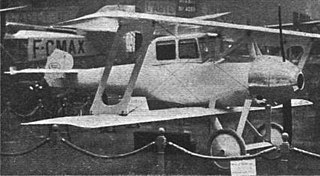
The Aero A.23 was a Czechoslovakian airliner of the 1920s. Aero Vodochody had produced the first Czech airliner, the A.10, four of which had served with ČSA, the national airline. The A.23, another biplane, was bigger, more powerful and could carry more passengers.
The Indraéro Aéro 30 is a single seat, single engined sports biplane designed in France in the late 1960s. Only one was built.

The Burnelli RB-1 was a US twin engine biplane airliner prototype from 1920, incorporating a lifting body fuselage.

The Stolp-Adams SA-100 Starduster is a U.S. single seat sport biplane designed to be built from plans supplied by Aircraft Spruce & Specialty Co. Though the first flight was in 1957, Stardusters continue to be built and flown.
The Hovey Delta Bird is an American ultralight aircraft that was designed by Bob Hovey in 1982 and supplied as plans for amateur construction.

The Caproni Ca.125 was a single-engine, tandem two-seat, touring biplane built in Italy in 1933. It could be operated either as a landplane or seaplane.

The Curtiss Model 22 Cox Racers were two specialised racing aircraft built by the American Curtiss Aeroplane and Motor Company. The type was flown as a monoplane, biplane and triplane.

The Hanriot H.26 was a French single seat fighter aircraft prototype completed in 1923. Only one was built.
The Potez 26 was a single seat fighter aircraft designed and flown in France in the mid-1920s. It did not reach production.
The Potez 27 was a French reconnaissance biplane first flown in 1924. 175 were operated by the Polish Airforce, most built in Poland by PWS under licence. Others went to Romania, where they were also used as light bombers.

The Descamps 17 A.2 was a two-seat reconnaissance fighter built under a French government programme of 1923. Two versions, with different engines, were tested and six examples were built under licence by Caudron as the Caudron C.17 A.2.

The de Marçay Limousine was a two-seat French touring biplane introduced at the 1919 Paris Aero Salon. A smaller but otherwise very similar single-seater was also there.

The Les Mureaux 3 C.2 and Les Mureaux 4 C.2 were French two seat, parasol winged fighters, flown in 1927-8, which differed only in their engines. They were developed into near identical army co-operation types, the ANF Les Mureaux 130 A.2 and ANF Les Mureaux 131 A.2, in 1929-31.

The Heinkel HD 20 was a twin engine, three seat German biplane built in 1926 for civil survey work.
The Aerial Service Mercury Senior, Aerial Mercury Senior or just Mercury Senior was a US biplane mailplane designed to operate at night between New York City and Chicago. A different, smaller, lower wing improved its performance for daytime flights. One was built and used by the United States Post Office Department.

The Aerial Engineering Corporation Standard 6W-3 was a commercial transport modification of the US Standard J-1 biplane military trainer aircraft, with new wings, engine and accommodation for four passengers. First flown in 1925, it was built in small numbers.

The Skraba S.T.3 was a two-seat Polish biplane built in 1928. It was the first all-metal aircraft designed in Poland; only one was completed.

The Thulin E was a Swedish reconnaissance aircraft built in the late 1910s.

The Johnson Twin-60 was a small, two seat biplane intended for private owners. It had twin engines for safety and the performance and undercarriage designed for short and rough field use. Despite its refinements only one was definitely built

The NAS Air King was a US light biplane transport aircraft designed in 1926 to carry three passengers in two open cockpits. Only one was built but in 1928 it was revised to carry two passengers and was more successful, with over twenty produced.
















